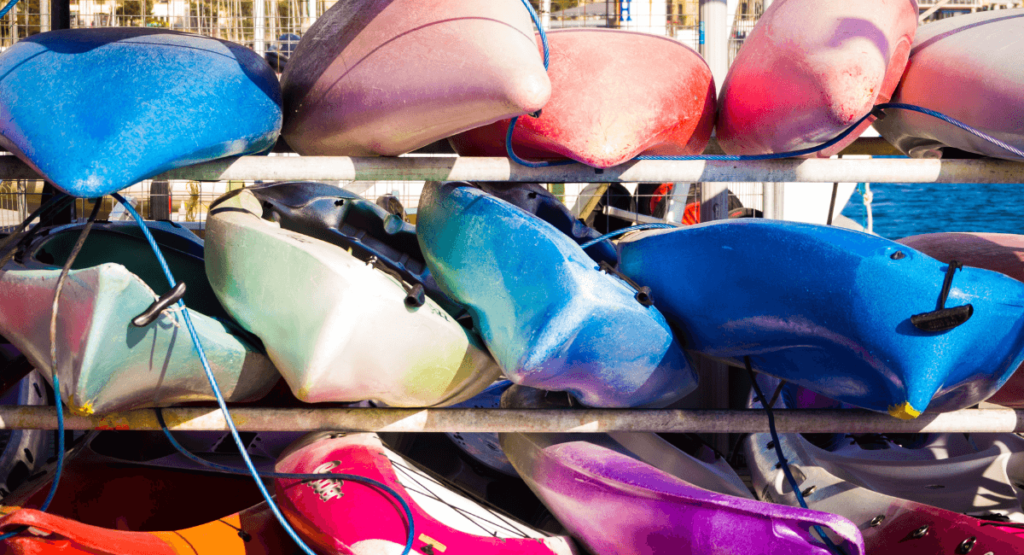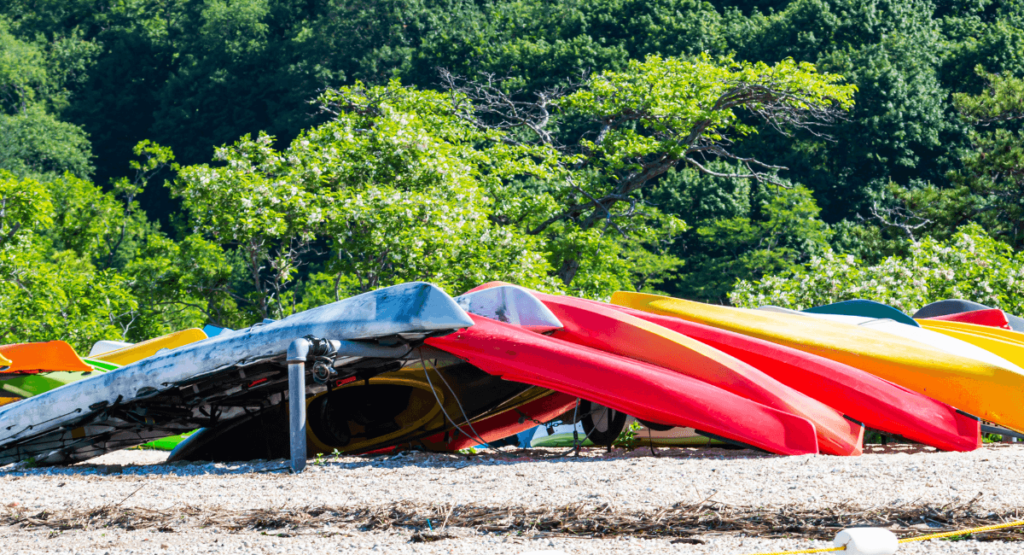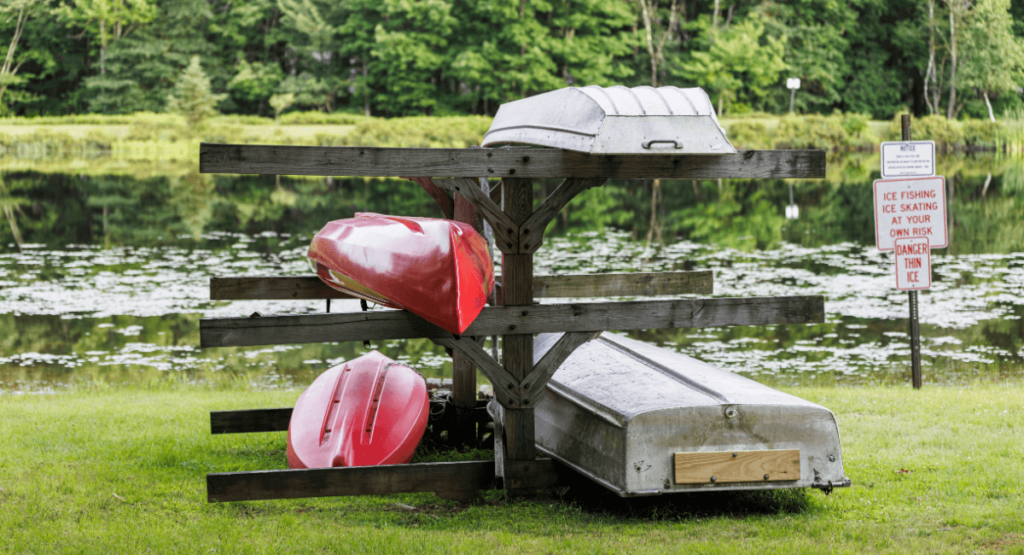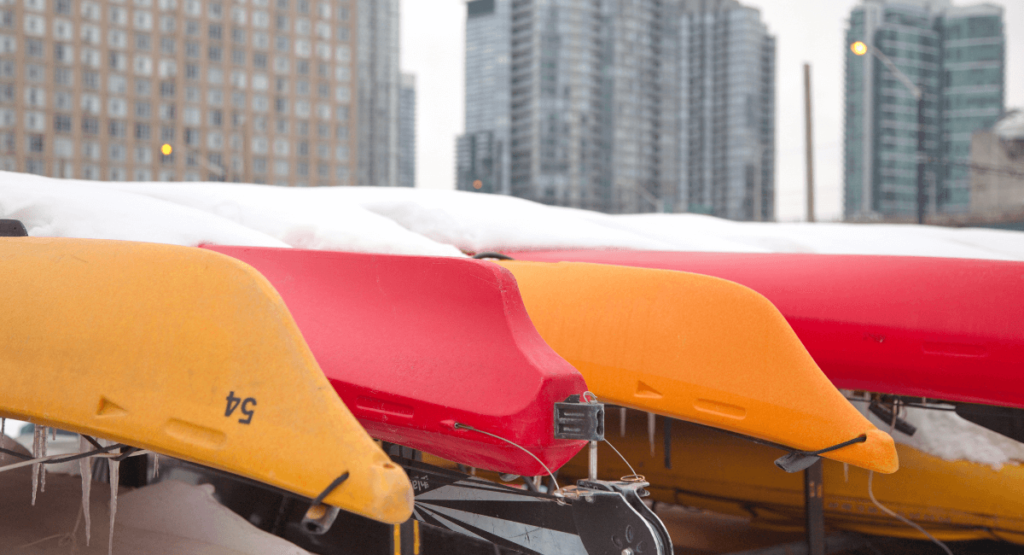Yes, kayaks can be stored outside in winter, but it’s best to cover them diligently. Proper kayak covers can prevent damage caused by snow, ice, and freezing temperatures.
It’s essential to protect your kayak to ensure its longevity and maintain its functionality. Winter weather can be harsh, so taking precautions to store your kayak correctly is crucial. By following some simple steps, you can safely store your kayak outside during the winter months.
Let’s explore the best practices for storing kayaks outdoors in winter to keep them in peak condition for your next adventure.
Benefits Of Outdoor Storage
When considering the winter storage of your kayak, the decision between outdoor and indoor storage is an important one. Outdoor storage has its own advantages, and understanding these benefits can help you make an informed choice. This article highlights the benefits of outdoor storage for kayaks.
Convenience
Outdoor kayak storage offers unparalleled convenience. Instead of maneuvering your kayak in and out of your garage or basement, you can simply leave it outside, ready for use whenever you want to hit the water.
Saving Garage Space
Storing your kayak outdoors allows you to reclaim valuable garage or basement space. This space can be used for storing other equipment, vehicles, or for any other purposes, providing you with a more organized and spacious living space.
Risks Of Outdoor Storage

When leaving kayaks outside during winter, there are several risks to consider that can lead to potential damage. It’s crucial to assess these risks to ensure the longevity and performance of your kayak.
Damage From Freezing Temperatures
Freezing temperatures can cause the plastic or composite material of the kayak to become brittle, leading to cracks and structural weakness.
- Ice formation can exert pressure on the hull, resulting in deformation and warping.
- Any water left inside the kayak can freeze and expand, causing damage to the vessel.
Uv Damage
Exposure to UV rays can accelerate the degradation of the kayak’s material, leading to fading, weakening, and potential breakdown.
- UV damage can affect the integrity of the hull, making it more susceptible to cracks and leaks.
- Continuous exposure to sunlight can weaken the kayak’s surface, affecting its overall performance and durability.
Preparation For Outdoor Storage

Winter is a challenging time for kayaks left outdoors. To prepare for outdoor storage, ensure your kayak is clean, dry, and covered to shield it from harsh weather conditions. Consider using a protective tarp and storing it in a sheltered area away from snow and ice to maintain its condition for future use.
Cleaning And Drying
Before storing a kayak outside during winter, clean it thoroughly with mild soap and water to remove salt or dirt.
Ensure the kayak is completely dry to prevent mold or mildew growth which can damage the material.
Covering And Securing
- Cover the kayak with a durable tarp to shield it from snow, rain, and sunlight that can cause fading or cracks.
- Secure the tarp tightly with bungee cords or straps to prevent it from blowing away in strong winds.
Choosing A Suitable Location

When it comes to storing kayaks outside during winter, choosing a suitable location is paramount for preserving the integrity of your equipment. Proper storage can protect your kayak from environmental damage and ensure it’s ready for use when the warmer months arrive. Let’s explore some important considerations for finding the ideal location to store your kayak during the winter season.
Sheltered Area
Selecting a sheltered area for your kayak storage is essential. This could be a dedicated storage shed, garage, or any other covered space that protects from the elements. Exposure to harsh weather conditions can cause damage to the kayak’s material and compromise its structural integrity. A covered area shields the kayak from snow, rain, and winds, helping to prevent deterioration and extending its lifespan.
Avoiding Direct Sunlight
Avoiding direct sunlight is crucial when storing your kayak outside during the winter. Direct sunlight, especially when combined with freezing temperatures, can cause the kayak’s material to degrade over time. UV radiation can gradually break down the surface of the kayak, leading to fading, brittleness, and a reduction in overall performance. Choose a shaded location that shields the kayak from direct sun exposure to maintain its quality.
Additional Tips

When it comes to storing your kayak outside during the winter months, there are a few additional tips that can help protect it from the harsh elements. By following these guidelines, you can ensure that your kayak stays in great condition and is ready to hit the water when spring rolls around.
Regular Inspection
Regularly inspecting your kayak throughout the winter is essential to identify any potential issues before they become more serious. Check for any cracks, leaks, or damage to the hull, as well as any signs of pests or moisture build-up. By catching these problems early on, you can prevent further damage and make any necessary repairs before the paddling season begins.
Using Protective Coatings
Applying a protective coating to your kayak’s hull can provide an extra layer of defense against the winter elements. Whether you choose a specialized kayak wax, UV protectant spray, or marine-grade paint, a good coating can help shield your kayak from harmful UV rays, moisture, and freezing temperatures. Be sure to follow the manufacturer’s instructions when applying the coating for maximum effectiveness.
Proper Storage
When storing your kayak outside during the winter, it’s important to find a suitable location that offers protection from the elements. Look for an area that is sheltered from wind, snow, and excessive sunlight. If possible, elevate the kayak off the ground to prevent moisture and critters from accessing it. Using a kayak cover or tarp can also provide an extra layer of protection from rain, snow, and debris.
Secure Anchoring
Ensuring that your kayak is securely anchored during the winter months is crucial to prevent any potential damage from strong winds or storms. Use sturdy straps or ropes to secure the kayak to a solid structure, such as a fence or shed. This will help prevent it from being blown or knocked over, reducing the risk of damage.
Regular Cleaning
Even when not in use, it’s important to keep your kayak clean throughout the winter. Remove any dirt, sand, or salt residue from the hull, cockpit, and storage compartments. This will help prevent corrosion and damage to the kayak’s surfaces. Additionally, ensure that all equipment, such as paddles and life jackets, are clean and properly stored.
Summary
By following these additional tips for storing your kayak outside during the winter, you can protect your investment and ensure that it remains in excellent condition. Regular inspection, using protective coatings, proper storage, secure anchoring, and regular cleaning are all key factors in keeping your kayak ready for the next paddling season.
Alternatives To Outdoor Storage

Storing kayaks outside during winter can cause damage and reduce their lifespan. If you don’t have indoor storage space available, there are a few alternatives to consider. These options protect from the harsh winter elements. Let’s explore some indoor storage alternatives that will keep your kayak safe and sound.
Indoor Storage Options
Indoor storage is the ideal option to protect your kayak during winter. Here are a few indoor storage alternatives:
- Garage or Basement: If you have access to a garage or basement, this can be a convenient and cost-effective option for kayak storage. Make sure you have enough space and consider using wall-mounted racks or ceiling pulley systems to save space and keep your kayak out of harm’s way.
- Spare Room or Closet: If you have a spare room or a large closet, you can utilize this space for kayak storage. Just ensure that the room is dry and well-ventilated to prevent any damage from moisture.
- Shed or Outbuilding: If you have a shed or outbuilding on your property, it can be repurposed as a kayak storage area. Ensure that the space is insulated and secure, protecting your kayak from extreme temperatures and potential theft.
Professional Storage Services
If you don’t have indoor storage space available, you can always consider professional storage services:
- Self-Storage Facility: Self-storage facilities offer secure units in various sizes, suitable for storing kayaks. They protect from the elements, with climate-controlled options available. Look for a reputable facility with good reviews and convenient access for hassle-free storage.
- Marina or Boatyard: Some marinas or boatyards offer winter storage services for kayaks. This can be a convenient option if you live near the water. They often have dedicated storage spaces and may provide additional services like maintenance and repairs.
Consider factoring in the cost, accessibility, and security of these professional storage services when making a decision.
Frequently Asked Questions Can Kayaks Be Stored Outside In Winter
Can Kayaks Be Stored Outside In Winter?
Yes, kayaks can be stored outside in winter, but it is important to take proper precautions. Ensure that the kayak is thoroughly cleaned and dried before storage. Cover it with a durable tarp or kayak cover to protect it from harsh weather conditions.
It is also recommended to store it in a sheltered area to prevent damage from heavy snow or ice. Regularly check for any signs of damage or wear during storage.
Conclusion
It’s important to carefully consider where you store your kayak during the winter months. By following the proper steps and precautions, you can ensure that your kayak remains in good condition and ready for use when the warmer weather returns.
Proper storage is key to preserving the integrity of your kayak.
